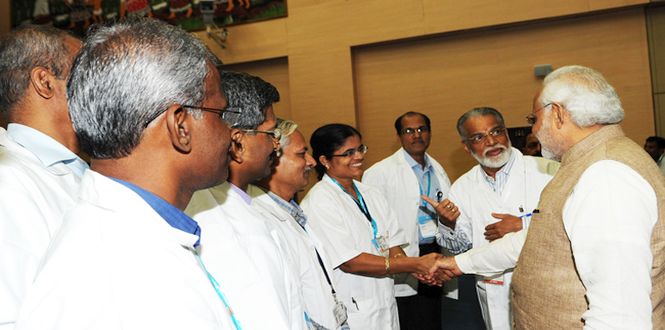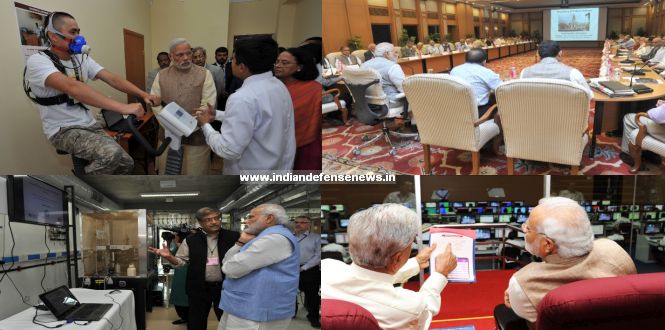
The Prime Minister, Shri Narendra Modi meeting the scientists after the successful launch of PSLV C23, at the Mission Control Centre, at Sriharikota, in Andhra Pradesh on June 30, 2014. The ISRO Chairman, Dr. K Radhakrishnan is also seen.
“there lives a Newton in every student of science” – Narendra Modi Circa 2010
by Shradha Singh
Science and technology are closely linked aspects of society and the studies and developments in both these fields are essential for the overall progress of mankind. Also, much like any other indicator of a progressive nation, an upscale in innovation and research in these domains pretty much determines the place of a country on the prosperity ladder.
Over the past 18 months, the government has actively engaged with the scientific community in the country. “Actively” does not refer only to meeting scientists and congratulating them on their achievements, but taking constructive steps to promote and sustain scientific temperament in the country.
![]()

Taking into account the fact that India has 54% of the population below the age of 25 years, the government, working at the grassroots level, announced that the number of scholarships under National Talent Search Scheme (NTSE) would now be 2000 instead of 1000 scholarships awarded currently. The scholarships are awarded to the candidates for pursuing courses in sciences and social sciences up to doctoral level and in professional courses like medicine and engineering up to second-degree level subject.
A candidly written piece by a young scientist Dr. Kaneenika Sinha in the Swarajya Magazine, reflects PM Narendra Modi’s awareness of the numerous challenges faced by the scientific community and his unrelenting efforts to address them. At a meeting with 30 scientists in August this year, not only did the PM raise questions over the presentations made seeking an explanation, but also asked for the submissions of proposals to remove some of the road-blocks hampering research productivity.
Dr. Sinha had written,“One point that the PM kept making repeatedly was that the solutions to most of the problems—be it coordination of resources or addressing specific needs of the nation such as Swachh Bharat, cleaning the Ganges, low agricultural productivity, the contradictory problems of malnutrition and food wastage, better utilization of solar energy—would have to come from the scientists and not the bureaucracy. “Can you do it?” he asked us directly.”
The defense establishment of the country was further strengthened when Prithvi-II missile was successfully test fired, monitored by the scientists of Defence Research and Development Organisation (DRDO) in November last year. In August 2015 the successful launch of the latest communication satellite GSAT-6 by Indian Space Research Organisation (ISRO) scientists, perfecting the cryogenic engine technology, was crucial for India as now the government can save precious foreign exchange by launching communication satellites on its own.
Encouraging scientists “to explore the mysteries of science and not of government procedures” Prime Minister Modi had earlier addressed the gathering on the inaugural ceremony of the 102nd Indian Science Congress. Stating that it was his aim to ensure that the arms of science, technology and innovation reach the poorest, the remotest and the most vulnerable person in the country.
“We need to celebrate our scientific achievements as much as we rejoice in our success in other areas.We should give young participants and winners in science fairs maximum public recognition and sustained support of the government.I would personally love to meet the best of our young scientists.In conclusion, let me say for a safe, sustainable, prosperous future for India; or global leadership in a knowledge and technology intensive world, we need to put science, technology and innovation at the top of national priorities.I am confident that we can do it.”
Source>>





















